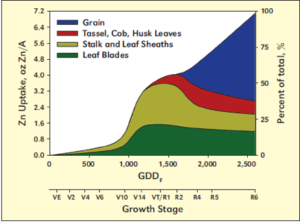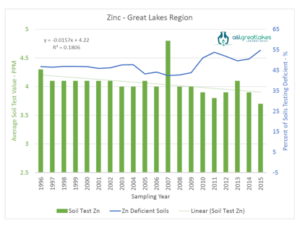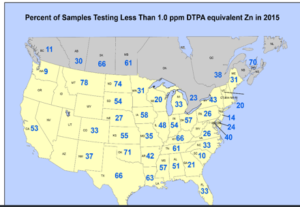As we continue to examine the micronutrients, let’s focus on Zinc.
Zinc performs multiple functions in a corn plant. It is important in many enzymatic reactions and protein synthesis, and can also impact hormone production which affects growth and can cause shortened or stacked nodes. In corn, interveinal chlorosis in young tissue can be a symptom of a zinc deficiency, although other nutrient deficiencies can look similar, so it is good to confirm with tissue and soil tests.
Zinc is taken up by the roots as the Zn++ cation and does not move much in the soil. Most uptake occurs via diffusion to the roots. A 200 bushel corn crop does not require large amounts of Zn – approximately – lb. Because Zinc does not move much in the soil banded applications either in-furrow or with the planter can be an effective method of supplying the needs of the plant. Also, in higher pH areas, acid- causing fertilizer applications in a band can help increase Zn availability.

Zinc deficiencies are becoming more commonplace throughout the midwest. Zinc can be mineralized from organic matter, so soils that are coarse textured or lower in OM may show deficiencies sooner. Also conditions such as cool/wet weather can reduce organic mineralization and limit root growth enhancing the possibility for deficiencies. High pH (above 7.0) and high phosphorus levels can also create conditions that induce Zn deficiencies.
Interestingly if you look at the uptake curves of Zinc nearly 70% of total uptake occurs over about 1/3 of the growing season. If environmental conditions limit Zn availability during these periods of rapid uptake, deficiencies can occur.
Data provided by A&L Great Lakes labs indicates that nearly55% of submitted soil samples from the region test deficient for
zinc. That is nearly identical to data from the International Plant Nutrition Institute’s recent large scale survey of soil samples (over 4,000,000 samples examined from 2015 across multiple soil labs and regions).
So what can we do to prevent and or correct the issues? Strong management through soil sampling is the first step. Keep in mind that when testing for micronutrients at these very low levels it can be challenging to get consistent results. Also because environmental conditions and other factors can impact availability, good soil test levels may not always tell the entire story. Even tissue testing may or may not be exactly accurate. It is a good idea to soil and tissue test in tandem over multiple years to help benchmark potential responses for your farm over time. You can then begin to try different  methods of application and different rates to correlate responses. Given time hopefully you will gain a better understanding of Zinc on your farm.
methods of application and different rates to correlate responses. Given time hopefully you will gain a better understanding of Zinc on your farm.